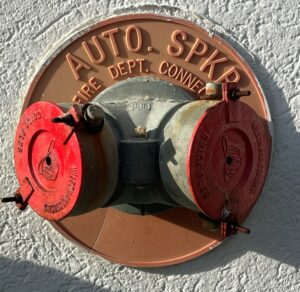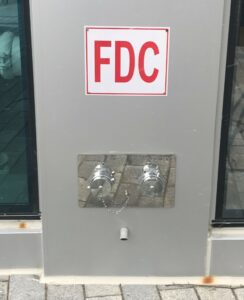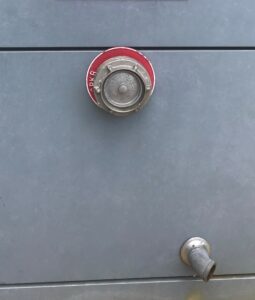Supplemental vs. Supply: Making Sense of Fire Department Connections

We talk a lot about the requirements for the installation of Fire Department Connections (FDC), but often leave out their intended use and the priority of pressurizing or supplying systems from those FDCs. There are very different considerations as to why we install an FDC on a building. Simply speaking, we have them for two different reasons: to supplement and supply.
Supplemental Pressure and Fire Department Connections
 NFPA 13 Standard for the Installation of Sprinkler Systems requires the installation of an FDC to allow the fire department to provide supplemental pressure. The connection is not intended to deliver a specific volume of water, nor is it needed for the system to operate. The fire sprinkler system is fully automatic and calculated to the system demand. This makes a fire sprinkler “only” FDC supplemental and less of a priority for the fire department to supply. The fire department will be initially deploying firefighting attack hose lines from apparatus. That becomes the priority over the supplementing of the FDC during the initial fire ground operation. This does not mean the connection should not be pressurized, just that it is not a requirement for the system to activate and provide appropriate system demand. In some fires where water system demand exceeds the system design pressure, it may move from a supplemental in nature to supply.
NFPA 13 Standard for the Installation of Sprinkler Systems requires the installation of an FDC to allow the fire department to provide supplemental pressure. The connection is not intended to deliver a specific volume of water, nor is it needed for the system to operate. The fire sprinkler system is fully automatic and calculated to the system demand. This makes a fire sprinkler “only” FDC supplemental and less of a priority for the fire department to supply. The fire department will be initially deploying firefighting attack hose lines from apparatus. That becomes the priority over the supplementing of the FDC during the initial fire ground operation. This does not mean the connection should not be pressurized, just that it is not a requirement for the system to activate and provide appropriate system demand. In some fires where water system demand exceeds the system design pressure, it may move from a supplemental in nature to supply.
Supplemental or Supply
Standpipe and combined automatic sprinkler/standpipes system FDCs can be either supplemental or supply. This places them in a different category on that priority list and the fire department must have a clear understanding of the type of systems installed in the building and their priority level for supplying. This is where signage requirements become extremely important, indicating the types of systems installed, required pressures and locations serviced by the system. NFPA 14 Standard for the Installation of Standpipes and Hose Systems requires these FDCs to be sized for system demand. In some installations, the fire department may need to provide part or the full system demand.
Combined Systems – Supply
 In the case of a combined automatic fire sprinkler/wet manual standpipe, the fire sprinkler system demand is provided from the building water supply. The automatic fire sprinkler portion of the system is fully operational without the use of the FDC, but the manual wet standpipe side needs to be supplemented by the fire department. The wet manual standpipe has domestic water in the system supplying the fire sprinkler demand, but does not have the required full standpipe system demand until supplemented or supplied by the fire department from the FDC. This makes the connection a priority that needs to be made immediately to supply the standpipe system demand required for operational firefighting.
In the case of a combined automatic fire sprinkler/wet manual standpipe, the fire sprinkler system demand is provided from the building water supply. The automatic fire sprinkler portion of the system is fully operational without the use of the FDC, but the manual wet standpipe side needs to be supplemented by the fire department. The wet manual standpipe has domestic water in the system supplying the fire sprinkler demand, but does not have the required full standpipe system demand until supplemented or supplied by the fire department from the FDC. This makes the connection a priority that needs to be made immediately to supply the standpipe system demand required for operational firefighting.
High-Rise – Pressure and Flow
 There are two separate things to consider when supplementing or supplying systems: pressure and flow. While these are related, they should be considered individually for the task that needs to be accomplished. According to the standard, a high-rise building is required to have two remotely located FDCs. The total number of combined inlets must be capable of supplying total system demand, but each FDC does not have to be able to supply the total system demand independently. While that might sound strange, the concept is simple. Most fires in high-rise buildings are located on floors where the fire department is predominantly providing redundant pressure for an automatic wet standpipe. The maintaining of pressure on the system can be done from either of the FDCs located on a building and does not necessitate the fire department pressurizing multiple connections. When pumping to higher elevations, a loss to the required flow ensues. As pressure requirements go up, the ability to provide required flow decreases. This is where the fire department will struggle in supplying tall buildings. While they can provide the maximum pressure of 250 psi from either of the connections, the ability to provide flow decreases to 50% of pump capacity. Once we start to reach these higher elevations the fire department will need multiple inlets to provide that additional required flow.
There are two separate things to consider when supplementing or supplying systems: pressure and flow. While these are related, they should be considered individually for the task that needs to be accomplished. According to the standard, a high-rise building is required to have two remotely located FDCs. The total number of combined inlets must be capable of supplying total system demand, but each FDC does not have to be able to supply the total system demand independently. While that might sound strange, the concept is simple. Most fires in high-rise buildings are located on floors where the fire department is predominantly providing redundant pressure for an automatic wet standpipe. The maintaining of pressure on the system can be done from either of the FDCs located on a building and does not necessitate the fire department pressurizing multiple connections. When pumping to higher elevations, a loss to the required flow ensues. As pressure requirements go up, the ability to provide required flow decreases. This is where the fire department will struggle in supplying tall buildings. While they can provide the maximum pressure of 250 psi from either of the connections, the ability to provide flow decreases to 50% of pump capacity. Once we start to reach these higher elevations the fire department will need multiple inlets to provide that additional required flow.
Large Diameter Fire Department Connections (LDH)
 Simply increasing the size of a single inlet will not be effective in this scenario. Large diameter hose pressure limitations restrict the ability to effectively push water to higher elevations. The limiting factor becomes the hose pressure maximums and pumping capabilities, not the size of the hose or FDC inlets.
Simply increasing the size of a single inlet will not be effective in this scenario. Large diameter hose pressure limitations restrict the ability to effectively push water to higher elevations. The limiting factor becomes the hose pressure maximums and pumping capabilities, not the size of the hose or FDC inlets.
NFPA 1962 Standard for the Care, Use, Inspection, Service Testing, and Replacement of Fire Hose, Couplings, Nozzles, and Fire Hose Appliances limits supply hose from exceeding pressures of 185 psi making them an ineffective choice when supplying standpipe connections. Using 2 ½ in. hose has been the standard choice for decades because it is considered an attack hose. Attack lines have higher maximum working pressures and are more likely to be able to provide the required maximum pump pressure of 250 psi found in NFPA Standard for Automotive Fire Apparatus.
System design considerations must include discussions with the fire department on fire apparatus-rated pump capabilities. Taking some time to consider how an FDC is used, or prioritizing the use of FDC will greatly enhance the overall design considerations for type, locations, and fire department needs.
The National Fire Sprinkler Association is Your Top Resource for Fire Protection Codes and Standards
Members and employees of the NFSA work very closely in the codes development process. Our team stays on the cutting edge of fire protection. For more information on the NFSA’s mission to protect lives and property through the widespread acceptance of the fire sprinkler concept, or to join our association, visit our membership page.
